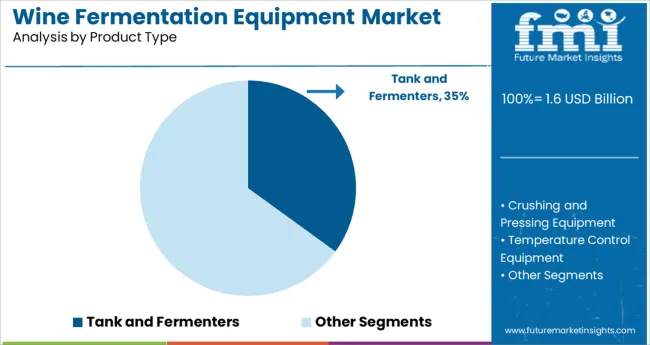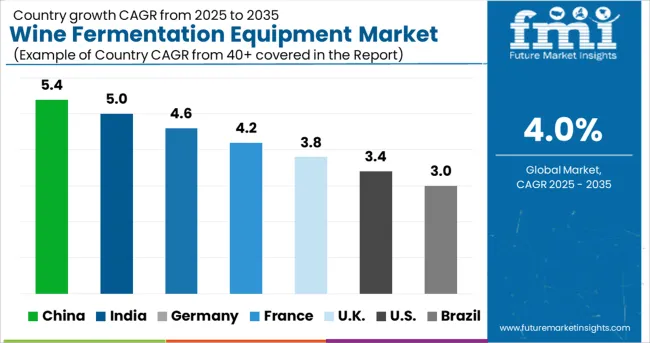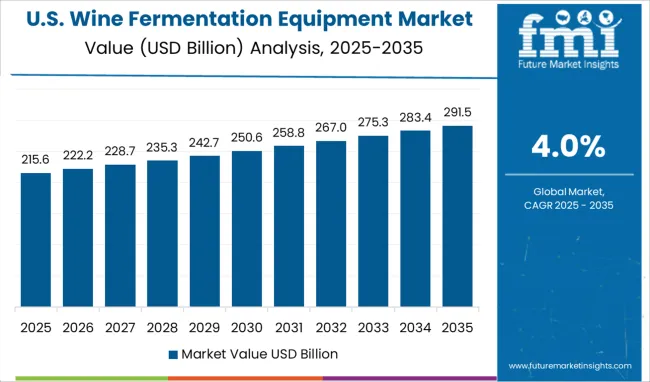The Wine Fermentation Equipment Market is estimated to be valued at USD 1.6 billion in 2025 and is projected to reach USD 2.4 billion by 2035, registering a compound annual growth rate (CAGR) of 4.0% over the forecast period.

The wine fermentation equipment market is undergoing consistent growth as sustainability priorities, technological advancement, and rising wine consumption globally reshape production practices. Producers are investing in modern fermentation solutions to enhance efficiency, maintain product consistency, and comply with hygiene and sustainability standards.
Increasing demand for premium wines and expanding vineyard operations are driving adoption of sophisticated equipment designed to optimize fermentation processes. Advancements in materials and automation technologies are enabling manufacturers to offer durable and energy efficient solutions, further supporting market expansion.
Future growth is expected to be propelled by continued innovation in temperature control systems, rising consumer interest in boutique and organic wines, and the need for scalable solutions to meet dynamic production demands. Strategic collaborations between equipment suppliers and wineries are fostering innovation and paving the way for broader adoption across both large scale and artisanal producers.
The market is segmented by Product Type and Application and region. By Product Type, the market is divided into Tank and Fermenters, Crushing and Pressing Equipment, Temperature Control Equipment, and Filtration Equipment. In terms of Application, the market is classified into Commercial Kitchen, Household Kitchen, and Others. Regionally, the market is classified into North America, Latin America, Western Europe, Eastern Europe, Balkan & Baltic Countries, Russia & Belarus, Central Asia, East Asia, South Asia & Pacific, and the Middle East & Africa.

When segmented by product type, the tank and fermenters segment is projected to account for 35% of the market revenue in 2025, establishing itself as the leading product type. This leadership has been shaped by the critical role these units play in ensuring controlled and efficient fermentation, which directly impacts wine quality and consistency.
Their versatility in accommodating various wine styles and volumes has made them indispensable for both large scale and craft producers. Innovations in stainless steel construction, internal cooling systems, and automated monitoring features have enhanced operational efficiency and improved sanitation standards, contributing to their widespread adoption.
The ability of tanks and fermenters to integrate seamlessly with modern winery layouts and support environmentally responsible practices has further reinforced their prominence in the market. Demand for equipment that combines durability with precise control has solidified this segment’s position as the cornerstone of wine fermentation operations.

Segmented by application, the commercial kitchen segment is forecast to hold 42.5% of the market revenue in 2025, affirming its position as the dominant application segment. This dominance has been underpinned by the growing presence of commercial kitchens and hospitality venues producing house wines to enhance customer experience and differentiate their offerings.
The ability to produce small batches on site has gained appeal as consumers increasingly favor locally crafted and personalized wine experiences. The segment’s growth has also been supported by advancements in compact, user friendly fermentation equipment that can fit into constrained kitchen spaces without compromising on quality.
Operators have been leveraging these solutions to reduce supply chain dependence and improve margins by creating unique, value added products. Enhanced consumer engagement, coupled with rising expectations for authenticity and sustainability in dining experiences, has strengthened the role of commercial kitchens as key adopters of wine fermentation equipment.
As per FMI, the global wine fermentation equipment market exhibited steady growth at a CAGR of 3.3% during the historical period. This growth was attributed to the rising application of wine fermentation equipment to ease the processing of wine worldwide.
Increasing adoption of automation and robotics in winemaking is projected to create new opportunities for wine fermentation equipment manufacturers. Winery motion automated equipment, automated packaging, and temperature controls are some of the state-of-the-art features that are being developed by renowned companies across the globe.
As per Wine Institute, in 2024, nearly 1.5 million 9-liter cases of wine were shipped from California to all markets in the USA and abroad. In 2024, wine shipments from California reached 269.2 million 9-liter cases. These numbers are estimated to grow at a rapid pace in the next ten years, thereby driving the global market.
A number of influential factors have been identified to stir the soup in the wine fermentation equipment market. Besides the proliferating aspects prevailing in the market, the analysts at FMI have also analyzed the restraining elements, lucrative opportunities, and upcoming threats that can pose a challenge to the progression of the wine fermentation equipment market.
The drivers, restraints, opportunities, and threats (DROTs) identified are as follows:
DRIVERS
RESTRAINTS
OPPORTUNITIES
THREATS

Relaxed Trade Duties in the USA to Propel Sales of Wine Fermentation Kits by 2035

According to FMI, the wine fermentation equipment market in the USA is set to grow at a CAGR of 38% in the next ten years. Since time immemorial, massive demand for wine has been the source of all USA manufacturers’ inspiration, encouraging them to come up with innovative products.
Also, relaxed trade duties and tariffs in the country are projected to boost the popularity of wine in the USA as per the Wine Institute, in 2024, the total wine consumption per resident was 3.18 gals, while it was 3.07 gals in 2024.
The emergence of Sensorial & Premium Brands in Germany to Drive the Demand for Wine Fermenter Buckets
Europe is witnessing a two-fold increase in the production of wine, with Germany at the top of the list. This is because customers in the nation are becoming more interested in sustainable food and beverage products that also have various health advantages.
According to FMI, the German wine fermentation equipment market is expected to grow at a CAGR of 4.4% in the evaluation period. Consumption of wine in the country is nowadays more associated with a lavish and wealthy lifestyle of consumers. They are looking to purchase a wide variety of products with distinct tastes, which is compelling key companies to come up with sensorial and premium brands in the German market.
In September 2025, Weingut Battenfeld Spanier, a reputed German wine estate, unveiled its ‘rising star’ Riesling on La Place through ne?gociant Maison Ginestet. The C.O Liquid Earth Riesling does not fall under the standard site categorization as it was sourced from a selection of the oldest vines.
Launch of China-exclusive Wines to Boost Sales of Wine Fermentation Vessels by 2035
According to FMI, the wine fermentation equipment market in China is estimated to showcase rapid growth in the assessment period. Innovation in flavor and premiumization of wine products are mainly responsible for pushing sales of wine fermentation equipment in the country.
In August 2025, for instance, Penfolds, a flagship Australian wine brand, which is owned by Treasury Wine Estates, introduced a China-exclusive wine at the country’s VATS Liquor Store, which is the most renowned nationwide spirits and wine distributor.
Penfolds Tribute 177 is made from Californian grapes and was developed primarily for VATS Liquor Store only for the mainland Chinese market. Such product launches catering to the taste and requirements of Chinese consumers are projected to augur well for the market.
Introduction of Canned Products in the UK to Augment Sales of Red Wine Fermentation Tanks
During the projected period, the UK is expected to be one of the fastest-developing markets for wine fermentation equipment, says FMI. The country’s wine fermentation equipment industry is being driven by increasing demand for wine in cafeterias, hotels, quick-service restaurants, and full-service restaurants.
Premiumization is also becoming a part of ongoing trends among millennials and gen Z, thereby attracting long-term revenue by key companies in the UK Introduction of canned products by various wine-making companies in the country to provide high convenience and portability to consumers would also help the market to grow in the UK
In September 2025, for instance, British Airways announced the launch of its new online wine shop by collaborating with IAG Loyalty. It will enable consumers to utilize their Avios loyalty points to collect points from online wine purchases, as well as buy wine. Similar initiatives taken by various renowned companies in the UK are anticipated to push sales.
The emergence of Marijuana-infused Beverages to Bolster Sales of Wine-Making Fermenters among Commercial Kitchens
Based on application, the global wine fermentation equipment market is segregated into commercial kitchens, household kitchens, and others. Out of these, the commercial kitchen segment is projected to dominate the market throughout the forecast period.
Key market players are nowadays focusing on the development of new flavored fortified wines to meet the changing consumer preferences. Thus, they are installing unique wine fermentation equipment and other associated tools in their manufacturing facilities.
The trend for consuming marijuana-infused wines is anticipated to surge at a rapid pace across developed countries worldwide. In March 2024, for instance, Raphael De Pablo, a young entrepreneur, launched the first wine infused with a cannabis extract in France. He named it the Burdi W Brand.
The global wine fermentation equipment market is projected to witness the entry of a large number of newcomers. They are set to provide advanced equipment to the food service industry globally. International companies are currently focusing on meeting the high demand from end users by launching new flavors of wines with the help of advanced machinery.
For instance:
| Attribute | Details |
|---|---|
| Estimated Market Size (2025) | USD 1.6 billion |
| Projected Market Valuation (2035) | USD 2.4 billion |
| Value-based CAGR (2025 to 2035) | 4.0% |
| Forecast Period | 2025 to 2035 |
| Historical Data Available for | 2020 to 2024 |
| Market Analysis | Value (million) |
| Key Regions Covered | North America; Latin America; Europe; Asia Pacific; Oceania; Middle East and Africa (MEA) |
| Key Countries Covered | USA, Canada, Mexico, Germany, UK, France, Italy, Spain, China, Japan, India, South Korea, Australia, Brazil, Argentina, South Africa, UAE |
| Key Segments Covered | Product, Application, Region |
| Key Companies Profiled | Adamark air knife system; Agrovin; Criveller Group; DT pacific LTD.; G.W.kentinc.; LoeMueller Company Inc; Grapeworks Pty Ltd; Vitikit Ltd |
| Report Coverage | Market Forecast, Company Share Analysis, Competitive Landscape, Drivers, Restraints, Opportunities and Threats Analysis, Market Dynamics and Challenges, and Strategic Growth Initiatives |
The global wine fermentation equipment market is estimated to be valued at USD 1.6 billion in 2025.
It is projected to reach USD 2.4 billion by 2035.
The market is expected to grow at a 4.0% CAGR between 2025 and 2035.
The key product types are tank and fermenters, crushing and pressing equipment, temperature control equipment and filtration equipment.
commercial kitchen segment is expected to dominate with a 42.5% industry share in 2025.






Our Research Products

The "Full Research Suite" delivers actionable market intel, deep dives on markets or technologies, so clients act faster, cut risk, and unlock growth.

The Leaderboard benchmarks and ranks top vendors, classifying them as Established Leaders, Leading Challengers, or Disruptors & Challengers.

Locates where complements amplify value and substitutes erode it, forecasting net impact by horizon

We deliver granular, decision-grade intel: market sizing, 5-year forecasts, pricing, adoption, usage, revenue, and operational KPIs—plus competitor tracking, regulation, and value chains—across 60 countries broadly.

Spot the shifts before they hit your P&L. We track inflection points, adoption curves, pricing moves, and ecosystem plays to show where demand is heading, why it is changing, and what to do next across high-growth markets and disruptive tech

Real-time reads of user behavior. We track shifting priorities, perceptions of today’s and next-gen services, and provider experience, then pace how fast tech moves from trial to adoption, blending buyer, consumer, and channel inputs with social signals (#WhySwitch, #UX).

Partner with our analyst team to build a custom report designed around your business priorities. From analysing market trends to assessing competitors or crafting bespoke datasets, we tailor insights to your needs.
Supplier Intelligence
Discovery & Profiling
Capacity & Footprint
Performance & Risk
Compliance & Governance
Commercial Readiness
Who Supplies Whom
Scorecards & Shortlists
Playbooks & Docs
Category Intelligence
Definition & Scope
Demand & Use Cases
Cost Drivers
Market Structure
Supply Chain Map
Trade & Policy
Operating Norms
Deliverables
Buyer Intelligence
Account Basics
Spend & Scope
Procurement Model
Vendor Requirements
Terms & Policies
Entry Strategy
Pain Points & Triggers
Outputs
Pricing Analysis
Benchmarks
Trends
Should-Cost
Indexation
Landed Cost
Commercial Terms
Deliverables
Brand Analysis
Positioning & Value Prop
Share & Presence
Customer Evidence
Go-to-Market
Digital & Reputation
Compliance & Trust
KPIs & Gaps
Outputs
Full Research Suite comprises of:
Market outlook & trends analysis
Interviews & case studies
Strategic recommendations
Vendor profiles & capabilities analysis
5-year forecasts
8 regions and 60+ country-level data splits
Market segment data splits
12 months of continuous data updates
DELIVERED AS:
PDF EXCEL ONLINE
Fermentation Equipment Market Size and Share Forecast Outlook 2025 to 2035
Wine Processing Equipment Market Size and Share Forecast Outlook 2025 to 2035
Micro Winery Equipment Market Size and Share Forecast Outlook 2025 to 2035
Commercial Winery Equipment Market Size and Share Forecast Outlook 2025 to 2035
Fermentation Enhancers Market Analysis - Size, Share, and Forecast Outlook 2025 to 2035
Wine Packaging Market Size and Share Forecast Outlook 2025 to 2035
Wine Bag Market Forecast and Outlook 2025 to 2035
Wine Cork Market Size and Share Forecast Outlook 2025 to 2035
Wine Barrel Market Size and Share Forecast Outlook 2025 to 2035
Fermentation Chemicals Market Size and Share Forecast Outlook 2025 to 2035
Fermentation Defoamer Market Size and Share Forecast Outlook 2025 to 2035
Wine Cellar Market Size and Share Forecast Outlook 2025 to 2035
Equipment Management Software Market Size and Share Forecast Outlook 2025 to 2035
Wine Enzymes Market Analysis Size Share and Forecast Outlook 2025 to 2035
Equipment cases market Size and Share Forecast Outlook 2025 to 2035
Wine Box Market Size and Share Forecast Outlook 2025 to 2035
Wine Fining Agent Market Size and Share Forecast Outlook 2025 to 2035
Wine, Scotch, and Whiskey Barrels Market Size and Share Forecast Outlook 2025 to 2035
Wine Totes Packaging Market Size and Share Forecast Outlook 2025 to 2035
Wine Racks Market Size and Share Forecast Outlook 2025 to 2035

Thank you!
You will receive an email from our Business Development Manager. Please be sure to check your SPAM/JUNK folder too.
Chat With
MaRIA